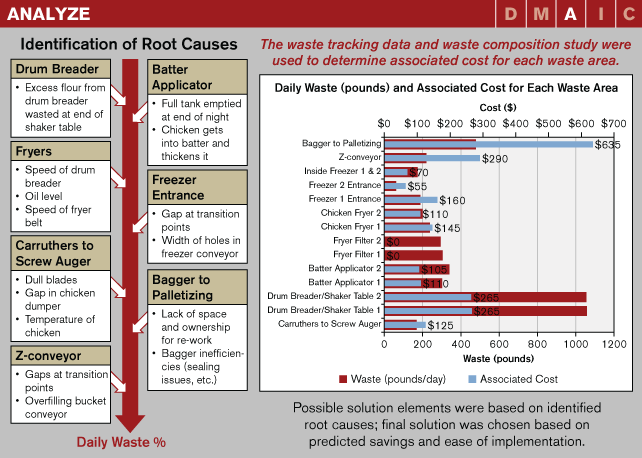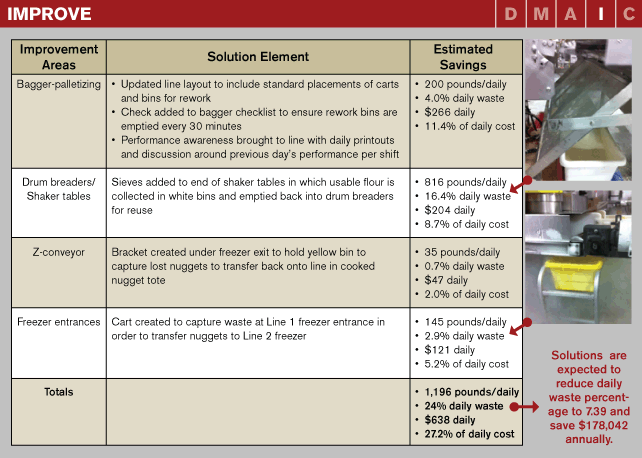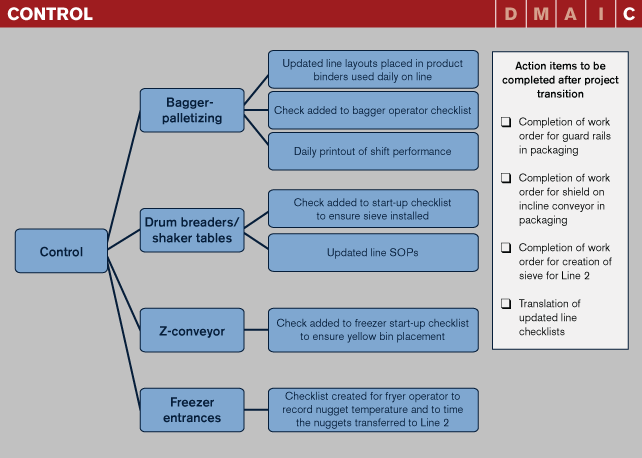
The following is Part Two of a two-part article. Part One follows the first two phases of a DMAIC (Define, Measure, Analyze, Improve, Control) project at Kahiki Foods. Part Two follows the completion of the project – the Analyze, Improve and Control phases.
Analyze
During the Analyze phase, the monitoring of the average amount of daily waste created at each of the 14 areas was based on the updated waste tracking system. A cost was linked to each area based on the waste composition study and cost of the type of lost material. The results can be seen in Figure 1.
Next, the core team held meetings to discuss each area in order of importance – based on associated loss in capital – and determine the root causes for waste creation. In these meetings, team members analyzed each waste area using the 5 Whys. After the meetings, statistical tests were used to either confirm or reject the proposed root causes, including one-way analyses of variance (ANOVA), correlation analyses and two-sample t-tests. The final root causes identified by waste area are shown on Figure 1.

Improve
The core team generated ideas for eliminating waste from each area of the chicken nugget production line based on the identified root causes. With the help of the project’s Champion, potential savings were calculated for each solution element along with a corresponding difficulty of implementation. Based on potential savings and difficulty level, four solution elements were approved to move to the pilot stage.
Initially, the solution elements regarding packaging (bagger to palletizing) were to 1) provide standard placements for rework and 2) add a check to be completed by the bagger operator every 30 minutes to ensure that rework bins had been emptied and were not overflowing. From these two changes alone, however, no significant shift was seen in the waste created. Based on this result – in addition to line observations and line knowledge – it was determined that the culture of keeping the line running at any cost had a larger role in the amount of waste created than initially thought. To create daily awareness among operators about their performance against the company’s goals, printouts of the previous day’s performance were discussed at daily shift meetings.
After piloting the idea to sift flour from the drum breader, the team determined that this idea required more operator attention than the savings warranted. An alternative solution, a sieve added to the end of the shaker table, was implemented; this new solution element was tested with successful results.
Two additional solution elements – a system for capturing lost nuggets on the z-conveyer and a cart to capture waste at the Line 2 freezer entrance – had successful pilots and required no changes.
The expected results from all the solution elements are a 24-percent reduction in daily waste percentage, to 7.39 percent, and a yearly savings of $178,042.

Control
Control elements were created to ensure the continuation of all solution elements. Daily checklists were either created or updated to confirm that the solution elements were being used daily; standard operating procedures (SOPs) were updated to show the changes in the process; and the practice of generating daily printouts of shift performance was implemented. All control elements for each improvement area are shown in Figure 5.
In addition to control elements, a project transition and sign-off document was created to ensure the full completion of all solution elements. The items left to be completed are also shown in Figure 3.
In order to continue tracking the line’s performance, the daily waste percentage will continue to be tracked in the KPI dashboard and the updated waste tracking system will continue to be followed.

Author’s note: Scott Sink, Director for the Integrated LeanSigma Certification Program in the College of Engineering/Integrated Systems Engineering (ISE) and Joe Cerrato, BSISE and Black Belt, The Poirier Group, served as Ms. Kinneberg’s coaches on the project. Special thanks to Tony Jones and Kahiki Foods for their continued support of the ISE Program and its candidates.